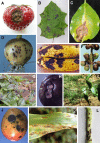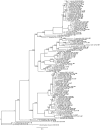Colletotrichum - current status and future directions
- PMID: 23136460
- PMCID: PMC3458418
- DOI: 10.3114/sim0014
Colletotrichum - current status and future directions
Abstract
A review is provided of the current state of understanding of Colletotrichum systematics, focusing on species-level data and the major clades. The taxonomic placement of the genus is discussed, and the evolution of our approach to species concepts and anamorph-teleomorph relationships is described. The application of multilocus technologies to phylogenetic analysis of Colletotrichum is reviewed, and selection of potential genes/loci for barcoding purposes is discussed. Host specificity and its relation to speciation and taxonomy is briefly addressed. A short review is presented of the current status of classification of the species clusters that are currently without comprehensive multilocus analyses, emphasising the orbiculare and destructivum aggregates. The future for Colletotrichum biology will be reliant on consensus classification and robust identification tools. In support of these goals, a Subcommission on Colletotrichum has been formed under the auspices of the International Commission on Taxonomy of Fungi, which will administer a carefully curated barcode database for sequence-based identification of species within the BioloMICS web environment.
Keywords: Colletotrichum; Glomerella; anamorph-teleomorph linkages; barcoding; database; host specialisation; phylogeny; species concepts; systematics.
Figures




References
-
- Abang MM, Winter S, Green KR, Hoffmann P, Mignouna HD, et al. (2002). Molecular identification of Colletotrichum gloeosporioides causing yam anthracnose in Nigeria. Plant Pathology 51: 63–71
-
- Adanson M. (1763). Familles des Plantes. Vincent, Paris:
-
- Afanador-Kafuri L, Minz D, Maymon M, Freeman S. (2003). Characterization of Colletotrichum isolates from tamarillo, Passiflora and mango in Colombia and identification of a unique species from the genus. Phytopathology 93: 579–587 - PubMed
-
- Agrios GN. (2005). Plant Pathology. 5th edn Academic Press, New York:
-
- Aguileta G, Marthey S, Chiapello H, Lebrun M-H, Rodolphe F, et al. (2008). Assessing the performance of single-copy genes for recovering robust phylogenies. Systematics and Biology 57: 613–627 - PubMed
LinkOut - more resources
Full Text Sources
Other Literature Sources
